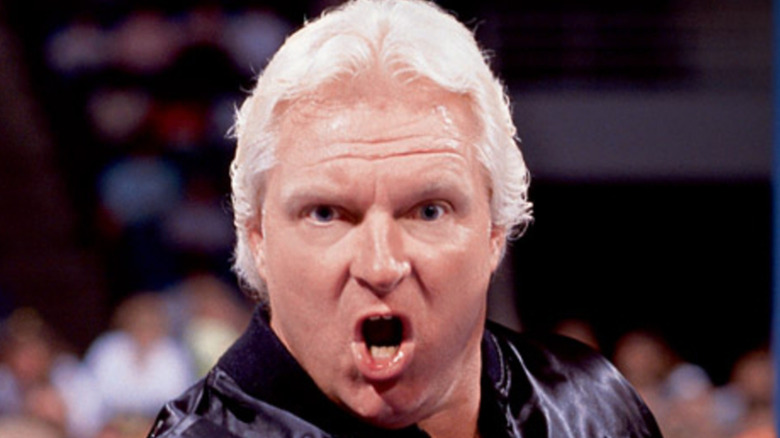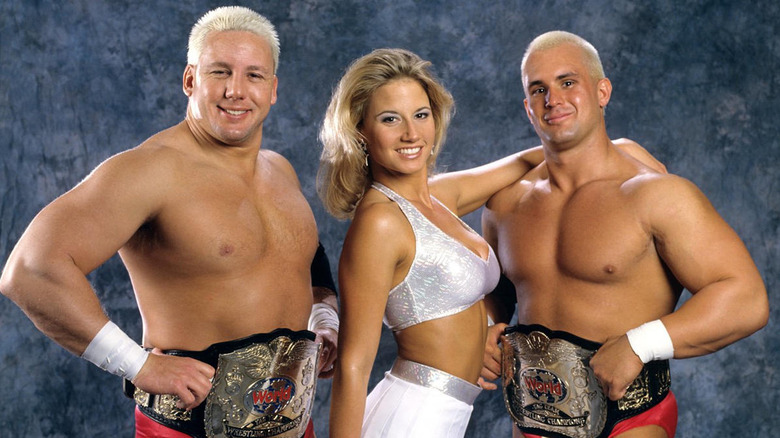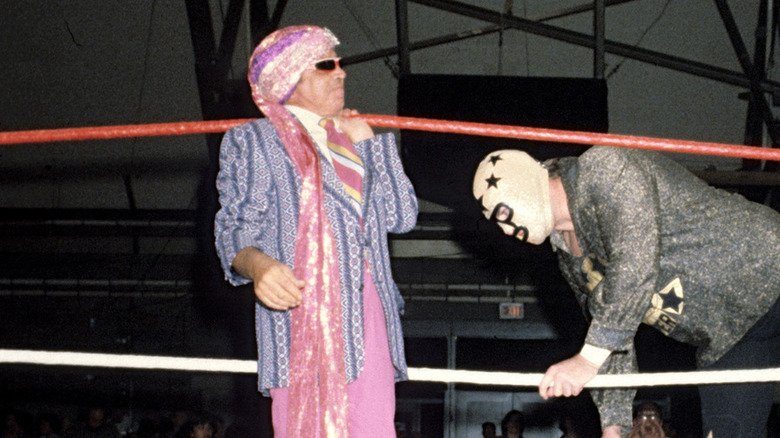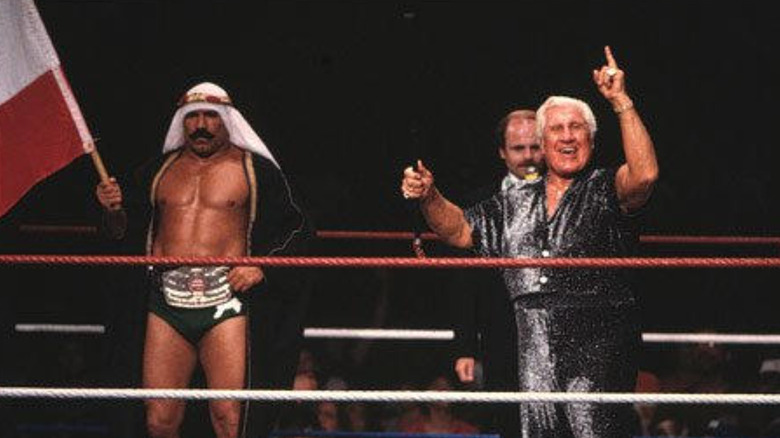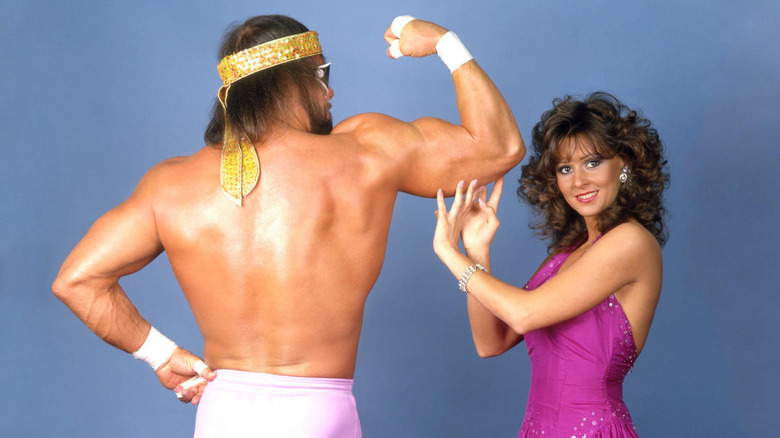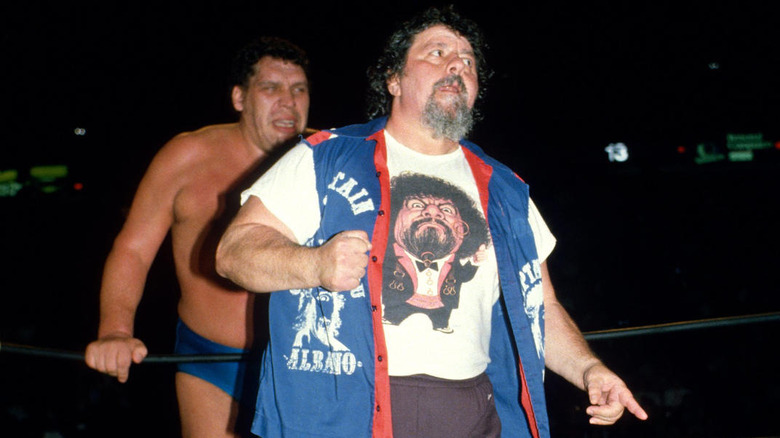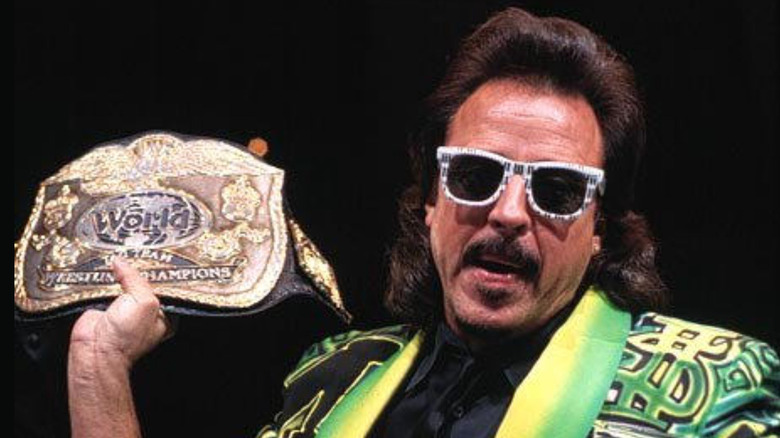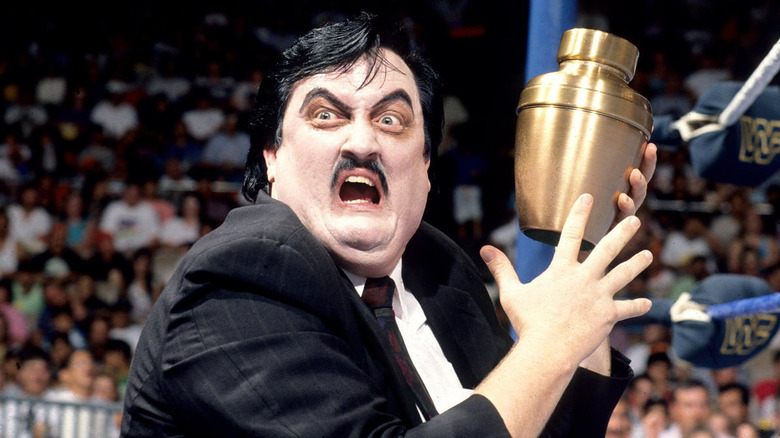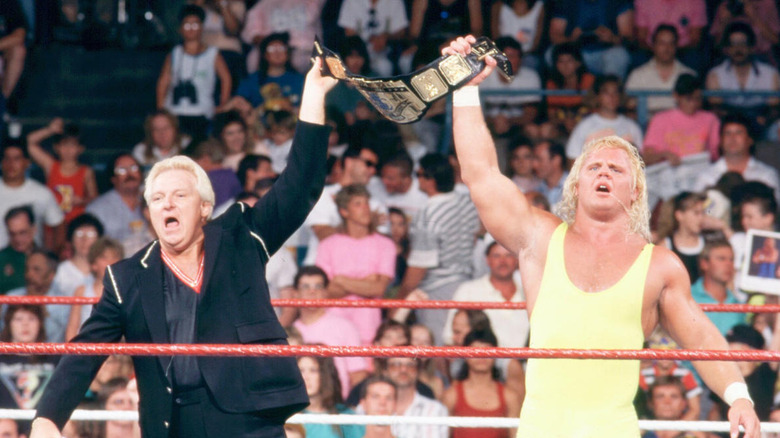The Best Managers In WWE History, Ranked
The importance of a wrestling manager has changed a lot over the years. At one time, managers gave wrestlers credibility or an added dimension. They supplemented what might have been a major weakness for a wrestler — the ability to work the microphone. For any wrestling fan who grew up in the 1980s (or earlier), managers were a critical part of weekly television. Over the last 20 years, though, it is undeniable that WWE has placed much less emphasis on managers. However, when given time to shine, a manager can still make a difference in the modern era.
There have even been managers throughout history who were more entertaining than their wrestler counterpart, and there have been managers who the wrestler grew jealous of, too. We've also seen the manager serve as a storyline device in wrestling feuds, a sort of tug of war between two competitors developing over the services or attention of said manager. (Remember WrestleMania V?)
So with all of this in mind, who were the biggest difference makers when it comes to managers in WWE over the last several decades? Let's take a look back at the best of the best.
12. Sunny
Tammy Sytch came to the WWF after making waves as part of Smoky Mountain Wrestling. Appearing as Sunny alongside her real-life boyfriend Chris Candido (Skip), it wasn't long before she was managing the WWF Tag Team Champions, Skip and Zip (Tom Prichard). The team, known collectively as the Bodydonnas, captured the gold at WrestleMania XII.
Sunny's 1996 was a big year. She managed three separate tag team championship teams as she changed her allegiances as the year progressed. She turned on The Bodydonnas by trading in spandex for flannel and denim to manage The Godwinns. That was short-lived, however, as Sunny turned on The Godwinns in favor of The Smoking Gunns. All three teams held tag team gold under her direction. Sunny also famously earned the distinction of being America Online's Most Downloaded Celebrity in 1996, and turned down an offer to appear in Playboy.
Sunny's time with the Gunns came to an end when she fired them after a tag team title loss at the WWF's In Your House: Mind Games pay-per-view. She was out of managing in the tag team ranks for a while after that, briefly returning to manage Faarooq before turning her attention toward various other roles on WWF broadcasts. When Candido left the WWF for ECW, Sunny started occasionally appearing on ECW telecasts. However, the WWF gave her one more managing role when she had a brief run as the manager for Legion of Doom 2000 in early 1998. She would be released from the promotion that summer.
11. Jim Cornette
Jim Cornette's exploits as a manager obviously extend well beyond the WWF. If this list was an all-encompassing breakdown of a managers' career across all promotions, he would rank much higher due to his time with the Midnight Express. However, for the purpose of this piece, we are concentrating specifically on his time with the WWF.
After a great amount of success as a manager throughout the 1980s and early 1990s, Cornette even started his own promotion (Smoky Mountain Wrestling) in 1991. Two years later, he began working for the WWF and was originally paired with Yokozuna as a spokesman. However, Cornette continued to run SMW during this period. He began taking on a more active role with the WWF when he managed Owen Hart and Yokozuna to the WWF Tag Team Championship at WrestleMania XI. Camp Cornette was born.
By that summer, The British Bulldog was on board, expanding the size of the Camp Cornette stable. The group grew by another member in early 1996 when Vader debuted with the WWF. A feud between Vader and Yokozuna developed (Yokozuna left Camp Cornette) and Cornette continued managing Vader, Hart, and Bulldog throughout much of the rest of the year. Hart and Bulldog eventually turned on Cornette to join Clarence Mason, leaving Vader as the last man left until he walked away with Paul Bearer.
Cornette's time as a manager with the promotion extended to 1998, when he led an NWA invasion angle with Jeff Jarrett, Barry Windham, the Rock 'n' Roll Express, Dan Severn, and a new version of the Midnight Express (Bob Holly and Bart Gunn). While Cornette never reached anything equivalent to his 1980s heyday with the WWF, he was always a memorable television character.
10. The Grand Wizard
The Grand Wizard was synonymous with gold in the World Wide Wrestling Federation in the 1970s and early 1980s, first leading the team of Professor Toru Tanaka and Mr. Fuji to the Tag Team Championships twice. He then set his eyes on singles gold, guiding Stan Stasiak to the WWWF Championship. A few years after Stasiak's title win, The Wizard took his biggest star to singles gold — Superstar Billy Graham.
It was alongside Graham that The Grand Wizard's career was the most memorable. Graham defeated the legendary Bruno Sammartino to win the title in Baltimore on April 30, 1977. When Bob Backlund won the title from Graham just under one year later, The Wizard began a feud with him. During that time, he sent a litany of stars after the champion. However, he wasn't done managing champions, either.
The Grand Wizard next looked upon on the newly created WWWF Intercontinental Championship, and he would manage no less than three stars to that title: Pat Patterson (the first Intercontinental Champion), Ken Patera, and Don Muraco. The Wizard tragically died of a heart attack in 1983 at the age of 57, but his influence on the wrestling industry lives on.
9. Arnold Skaaland
Arnold Skaaland was a legend as both a wrestler and a manager over the course of three decades with the World Wide Wrestling Federation, later the World Wrestling Federation. While his in-ring career was noteworthy, he was also serving as a producer and business partner alongside Vince McMahon, Sr behind the scenes.
Though his wrestling career was nothing to disregard, it was Skaaland's time as a manager that really put his name over the top. And how could that not be the case when you're managing someone like Bruno Sammartino? Alongside Skaaland, Sammartino captured the WWWF World Championship; he'd end up being known as one of the greatest champions (and biggest draws) in company history. And it wasn't just Sammartino who held top gold alongside Skaaland — he later managed Bob Backlund as well.
Skaaland was an early member of WWF's Hall of Fame, being inducted in 1994. He made his last appearances as a TV character that year, with Backlund turning on him to enhance his heel character.
8. Classy Freddie Blassie
Freddie Blassie was one of the most prominent figures in the WWF when the company began its national expansion in the early and mid-1980s. A great wrestler in his own right, much like Arnold Skaaland before him, Blassie turned to managing in the mid-1970s. Over the next decade-plus, he would manage a who's who of hall of famers. Names that benefitted from Blassie managing them included: Hulk Hogan, The Iron Sheik, Peter Maivia, Nikolai Volkoff, Adrian Adonis, Ray Stevens, Jesse Ventura, Dick Murdoch, George "The Animal" Steele, Kamala, Hercules Hernandez, Blackjack Mulligan, and many others.
One of Blassie's biggest moments of stardom came when he served as the manager for Muhammad Ali in his bout against Antonio Inoki, the infamous wrestler versus boxer match in Japan in 1976.
The course of wrestling history was changed in January 1984 when Hogan captured the WWF title from The Iron Sheik in Madison Square Garden. Blassie was there for all of it as the manager of The Iron Sheik, playing a heavy role during their feud as Hogan's ex-manager and now adversary. One year later, Blassie obtained more gold as a manager when he led Nikolai Volkoff and The Iron Sheik to the WWF Tag Team Championships at the first-ever WrestleMania event.
7. Miss Elizabeth
Elizabeth Hulette changed the game for female managers in professional wrestling. Coming at the tail end of an era dominated by The Grand Wizard, Lou Albano, and Freddie Blassie, Hulette was an integral part of her real-life husband's rise to stardom. Randy Savage wouldn't have been the same without Miss Elizabeth by his side.
With more eyeballs on the WWF than ever before following Vince McMahon's successful foray into national expansion, Elizabeth became a megastar during the mid-1980s. While her husband portrayed a jealous heel on television (something that sometimes wasn't far off from their real relationship), fans got behind Elizabeth as the damsel in distress who deserved better treatment. Her memorable interactions with George "The Animal" Steele during the build to WrestleMania III in 1987 stand out as a great example of this.
However, Savage eventually turned babyface and Elizabeth was still right there by her man's side, this time as an important part (or as called on TV, a secret weapon) of the Mega Powers team of Savage and Hulk Hogan. She reached the top of the promotion alongside Savage during this period, as the Macho Man became the WWF World Champion. Eventually, the pair split on television as Savage went heel once again and teamed with Sensational Sherri. However, the reunion between Savage and Elizabeth at WrestleMania VII remains one of the most emotional moments in WWE history.
6. Captain Lou Albano
It would be hard to have a list such as this without including Captain Lou Albano. Another notable name during WWF's expansion period in the mid-1980s, Albano even received mainstream attention when he was cast in Cyndi Lauper's music video for her mega hit "Girls Just Want To Have Fun," playing Lauper's father. Of course, Lauper was involved with the WWF at that time as well, leading the charge on the Rock 'n' Wrestling Connection that would springboard the WWF toward MTV exposure, WrestleMania, and national mainstream prominence.
Like many wrestling managers, Albano himself started out as a competitor. However, he transitioned to the managerial side in the early 1970s. Albano became synonymous with championship gold during the 1970s, 1980s, and 1990s as a manager. There are few in the history of the industry who have managed more champions. For Albano, that includes a record-setting 15 different tag team champions and four singles champions.
5. Sensational Sherri
Sherri Martel was not only a great manager, she was a great wrestler as well — a three-time AWA Women's Champion prior to joining the WWF in the late 1980s. However, it was her time in the WWF that of course made her a global superstar.
Sensational Sherri was a staple of WWF television for many years. She is most widely remembered for her pairings with Ted DiBiase, Randy Savage, and Shawn Michaels. Sherri's time with Savage was perhaps her most memorable as Savage went heel during his feud with Hulk Hogan, eventually winding up with Sherri by his side. This period oversaw Savage transforming himself into the Macho King, and Sherri was the perfect heel character at his side. This period culminated with Savage splitting with Sherri after his match with The Ultimate Warrior at WrestleMania VII. In the aftermath of that bout, Savage reunited with Miss Elizabeth in one of the most memorable WrestleMania moments of all time.
However, Sherri wasn't done. When Shawn Michaels split with Marty Jannetty to try his hand at becoming a singles star, Michaels was paired with Sherri. The veteran manager gave the young star just the right amount of credibility that he needed to succeed in the role while still growing as a performer. The love-stricken manager with the young heart-throb made for great television and helped to elevate Michaels as he would become one of the top WWF stars of the 1990s.
4. Jimmy Hart
Already a grizzled veteran of the Memphis territory by the time he reached the WWF in 1985, Jimmy Hart arrived in Vince McMahon's promotion just in time to cash-in on one of the most successful periods in wrestling history. He was a staple of television during the era. Seriously, it feels like if you name a WWF wrestler from the 1980s, there's got to be at least a one-in-four chance that Hart managed them at some point. He was always on TV.
Hart managed WWF Intercontinental Champion Greg Valentine at the first-ever WrestleMania event in 1985. That began what was a busy year for "The Mouth of the South" as he also took on managerial duties for Brutus Beefcake, King Kong Bundy, The Missing Link, Adrian Adonis, The Funk Family, and The Hart Foundation. Hart's time managing The Hart Foundation really helped put the team on the map as they began their WWF run as one of the best tag teams of the 1980s.
One of Hart's other most memorable pairings was with The Honky Tonk Man. Hart's simultaneous managing duties of The Hart Foundation, Adrian Adonis, and The Honky Tonk Man led to him appearing at ringside in three separate matches at WrestleMania III, one of the most legendary shows in company history. Hart would go on to continue managing Honky Tonk Man during his 14-month reign as WWF Intercontinental Champion later that year and into 1988.
And all of that was just a couple of years of his time with the WWF. Over the next several years, Hart managed many others, including (but not limited to) The Glamour Girls, The Natural Disasters, The Nasty Boys, Dino Bravo, The Fabulous Rougeau Brothers, The Mountie, Money Inc., and even Hulk Hogan during his final days with the WWF.
3. Paul Bearer
Paul Bearer's career alongside just one man, The Undertaker, could have ranked him this high on the list by itself, yet he was even able to reinvent himself late in his career and have a successful run as a manager for multiple other wrestlers to cement his place among the upper tier of wrestling's greatest managers.
Of course, Bearer's time alongside The Undertaker is what comes to mind first. After honing his craft as Percy Pringle, the character of Paul Bearer was made for William Moody. You can't think of the first several years of The Undertaker's run without envisioning Bearer by his side. Bearer's facial expressions and the high-pitched voice put the act over the top for a six-year run throughout the 1990s. It all culminated at SummerSlam 1996, with Bearer turning his back on The Undertaker, striking his client with the urn as he went off to manage Mankind.
While his run at Mankind's side was memorable as well, it was proved to be a bridge to his real rebirth as the manager for the debuting Kane. The teases of "Kane is alive" throughout the summer of 1997 eventually led to the big reveal at In Your House: Badd Blood in October 1997. With Bearer at his side, Kane was established as a top star right away. He feuded with The Undertaker for several months until he and Bearer split by the middle of 1998.
Bearer later reunited with The Undertaker several times, including as part of the Ministry of Darkness in late 1998 and 1999, as well as during the mid-2000s when The Undertaker went back to his Deadman roots.
2. Paul Heyman
Paul Heyman gets the nod as number two on this list for his importance to the success of two of the most dominant world champions in WWE history — Brock Lesnar and Roman Reigns. And that's not even everything the man has done since coming to the WWE.
Of course, Heyman had a lot of success prior to his WWE run. Paul E. Dangerously was one of the best managers in WCW before he took over ECW in the mid-1990s, but this is a WWE list and that's a tale for a different time. While he came over to the WWF in 2001 as an announcer to start, and he was later part of the Invasion storyline, it was his association with "The Next Big Thing" Brock Lesnar that cemented him as a top WWE manager. Lesnar was a blue chip star when he debuted in 2002, but there's no doubt he needed Heyman as mouth piece to succeed.
After turning on Lesnar, Heyman managed The Big Show to the world title. He also had a brief alliance with Kurt Angle, managing him during his third championship reign. When Rob Van Dam won the WWE Championship from John Cena in the summer of 2006, Heyman aligned with him briefly before turning on Van Dam to reunite with The Big Show as part of the now defunct WWE version of ECW.
Heyman then left WWE for nearly six years, but he returned for a memorable run with world champion CM Punk, a star he had long advocated for behind the scenes. He eventually reunited with Lesnar for several years before aligning himself with Roman Reigns and the Bloodline in recent years. Altogether, Heyman has managed six different world champions in WWE (Lesnar, Big Show, Angle, RVD, Punk, and Reigns), quite possibly an all-time record.
1. Bobby Heenan
There's not really a dispute, is there? Bobby Heenan is the greatest manager in WWE history. It's pretty tough to beat managing Andre The Giant at WrestleMania III. Heenan did that and a whole lot more.
While Heenan's greatness on color commentary could be an entire column all of its own, Heenan's bread and butter was as a manager. The list of wrestlers who he managed is a who's who of wrestling hall of fame talent: Andre The Giant, Rick Rude, Nick Bockwinkel, Ray Stevens, The Blackjacks, Harley Race, Mr. Perfect, Ric Flair, and so many more. Some of those names were of course prior to his WWF run, so as to remain true to the rest of this feature piece, let's concentrate solely on Heenan's time with the WWF.
Right at the top of the list of criteria for his selection as the greatest WWE manager of all time is the integral part he played in the build to WrestleMania III's main event pitting Andre The Giant against Hulk Hogan. As Andre's mouth piece, Heenan helped sell the match that filled up the Pontiac Silverdome. Andre had been a babyface for so long, but Heenan was able to get the fans to hate the beloved Giant. Both Heenan and Andre were pelted with garbage on their way up and down the aisle that night.
The Heenan Family group became a staple of television for years, and the wrestlers who were part of the group usually benefitted just by being associated with a man who was becoming a living legend in his own time. There will never be another one like him; Heenan's quick wit and comedic timing always had him standing out from the rest of the pack.
